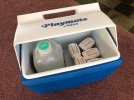- Joined
- Jan 7, 2018
- Messages
- 486
- Reaction score
- 540
- Age
- 71
- Location
- Long Island, NY
- Website
- www.zazzle.com
I finally earned my cold weather flying wings this past week, flying for 3 hours in 25F degree temps just hours before a major snowstorm hit the northeast. I had 5 batteries and needed a way to keep them warm. What I did worked really well. I placed a 1-gallon plastic container full of very hot water into a small picnic cooler along with my 5 batteries. This kept the batteries in a comfortably warm state until I needed to swap them. Naturally, I placed the batteries into a sealed plastic bag just in case the water container were to spring a leak. (Unlikely, but a possibility.) Wearing a lot of layers kept me toasty too. Flying in twenty five degrees wasn't as bad as I thought it was going to be.




